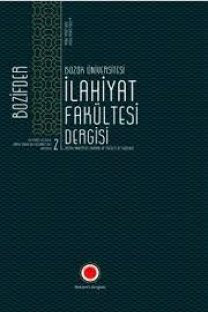İbn Kayyıma göre delil olma yönünden hadislerin tercihine dâir kriterler
İslam dininin iki temel kaynağı vardır. Bunlar Kuran ve Sünnettir. Sünnetin sözlü ifadesine hadis ismi verilmiştir. Çoğu âlime göre iki sahih hadis anlam bakımından muhalif olamaz, ancak çeşitli nedenlerle insanların zihinlerinde bazı hadisler arasında tezat varmış gibi algılanır. Cem ve telif ya da nesh ile iki hadis arasındaki tezat giderilirken, tercih ile de hadislerden biri çeşitli karineler dikkate alınarak muhalif görünen diğer hadise tercih edilir. İslam Tarihinde yazdığı eserler ile önemli bir yere sahip olan İbn Kayyim (ö. 751/ 1350) hadis tercihi konusunda dağınıkta olsa hatırı sayılır malumat kaydetmiştir. O, bir hadisi delil olarak tercih ederken, hadisin hem senedi hem de metnini dikkate almıştır. Ona göre senedi oluşturan râvilerin nitelik ve nicelik bakımından durumu, hadis metninin muhtevası ve yer aldığı kaynaklar bir hadisi tercih etmede etkili olan amillerdir. Bu makalede İbn Kayimin hadis tercihi konusunda kaydettiği kriterler incelenmiştir.
Anahtar Kelimeler:
Hadis, tercih, İbnKayyim, Muhalefet.
Views of Ibn Qayyim about the preference of hadith as proof
The religion of Islam has two fundamental sources. These are the Quran and the Sunnah. The oral expression of the Sunnah is called hadith. Under normal circumstances, two sound (sahih) hadiths cannot bear contradictory meanings that contradict each other. It is known however, that some hadiths can be perceived as having contradictions between them because of peoples defective understanding of them, or because of other similar reasons. Contradictions between two hadiths can be solved by way of gathering (Jam), reconciliation or byabrogation (naskh). It is also possibleto give preference to a hadith over - ortolet it outweigh another seemingly contradictory one (tarjih), by taking various internal evidence from the text (matn) into consideration. Ibn Qayyim al Jawziyya (d. 751/1350), who throughout his various works has an important position in the history of Islam, has recorded - albeit in a scattered form noteworthy information about the method of tarjih. When he gave preference to a hadith for using it as evidence, he took both its chain of narrators (isnad) andtext (matn) into consideration. According to him, among the factors indicating that a hadith should be given preference is the quality and quantity of the narrators in its chain, the contentand subject of the hadith in question and the sources in which it can be foun. İn this artical, concerning preference hadiths, the criterias of İbn Qayyim have been survyed.
Keywords:
Hadith, preference, IbnQayyim,
___
- 05. Ýbn Kayyim, Zâdü’l-Me’âd, II. Ahmed b. Hanbel (ö. 241/855), el-Müsned, thk.,Þuayb Arnavut, Müessesetü’rRisâle, y.y., 2001.
- Buhârî, Ebû Abdillah Muhammed b. Ýsmâil (ö. 256/869), el-Câmi’u’s-Sahîh, thk.
- ,Züheyr b. Nâsýr, Dâru Tavki’n-Necât Yay., 1. baský, I-IX, y.y. 1422.
- Buhârî, Ebû Abdillah Muhammed b. Ýsmâil (ö. 256/869), et-Târihu’l-Kebîr, Dâiretü’l-Me’ârif el-’usmaniye Yay, I-VIII, Haydarabadt.y.
- Ebû Abdurrahman, Abdulmecid Cum’a el-Cezâirî, ÝhtiyârâtuÝbni’l-Kayyým li Usuliyye,DâruÝbniHazm Yay., 1. Baský, I-II, Cezair 2005.
- EbûDâvûd, Süleyman b. Eþ’as es-Sicistânî (ö. 275/ 888), es-Sünen,thk., Muhammed Muhyiyu’d-Din Abdulhamid, elMektebetü’l-Asriyye Yay., I-IV, Beyrut t.y.
- ed-Dârekutnî, Ali b. Ömer (ö. 385/ 995), es-Sünen, thk.,Þuayb el-Arnavût, Müessesetü’r-Risale Yay., 1. Baský, I-V, Beyrut 2004.
- Ýbn Mâce, EbûAbdillah Muhammed b. Yezid el-Kazvînî (ö. 273/886), Sü- nen, thk., Muhammed FuadAbdulbâki, DâruÝhyâi Kütübi’l-’arabiyyi, I-II, y.y., t.y.
- Ýbn Kayyim el-Cevziyye, Þemsuddin Ebû Abdillah Muhammed b. Ebi Bekr b. Eyyub ez-Zura’ied-Dýmeþkî (ö. 751/1350), Tehzîbu’s-Sünen, thk. Ýsmail b. Gazi, Mektebetü’l-Me’ârif, I. bsk., Riyad 2007 . Ýbn Kayyim el-Cevziyye, Muhtasar esSavâ’iku’l-Mursele ‘ale’l-Cehmiyyeve’lMu’attýla, thk., Seyyid Ýmran, Daru’lHadîs Yay., I-II, Kahire 2004.
- Ýbn Kayyim el-Cevziyye, Ý’lâmu’l- Muvakki’în ‹an Rabbi’l ‹Âlemin, thk., ‘isamuddin es-Sabâbatî, Kahire 2004.
- Ýbn Kayyim el-Cevziyye, Zâdü’l-Me’âd fi Hedyi Hayri’l-‘Ýbâd, thk., Abdu’l- Kadir Ýrfanu’l-‘iþa, Daru’l-fikr Yay., I-V, Beyrut 2003.
- Müslim, Ebû’l-HuseynMuslim b. Haccac el-Kuþeyri (ö. 261/874), Sahihu Müslim, thk., Muhammed FuadAbdulbâki, DâruÝhyâi’t-Turasi’l-Arabî Yay., I-V, Beyrut t.y.
- en-Nesâî, EbûAbdirrahmanAhmed b. Þuayb (ö. 303/ 915), es-Sünenü’s-Suðra (el-Mücteba),thk.,Abdu’l-Fettah Ebû Gudde, Mektebetü’l-Matbû’ati’l- Ýslâmiyye Yay., I-VIII, Haleb 1986.
- en-Nesâî, es-Sünenü’l-Kübra, thk., Hasan Abdü’l-Münim Çelebi, Müessesetü’rRisâle Yay., I-X, Beyrut 200.
- eþ-Þâfî, Ebû Abdillah Muhammed b. Ýdris (ö. 204/ 819), er-Risâle, thk.,Ahmed Þakir, Mýsýr 1940/1358,
- eþ-Þâfî, el-Müsned, thk., Mahir Yasin, I-IV, Beyrut 2004.
- et-Tahâvî, Ebû Cafer Ahmed b. Muhammed (ö. 231/ 845), ÞerhuMuþkili’l-Âsâr, thk.,Þuayb el-Arnavut, Muessesetu’rRisale, I-XV, Beyrut 1415.
- et-Tirmizî, Ebû Ýsa Muhammed b. Ýsa (ö. 279/892), Sünen, thk.,Ahmed Muhammed Þakir, I-V, Mýsýr 1975.
- et-Tirmizî, eþ-Þemâilu’l- Muhammediyye, thk., Seyyid b. Abbas el Cüleymi, elMektebetü’t- Ticâriyye Yay., Mekke 1993.
- Yayın Aralığı: Yılda 2 Sayı
- Başlangıç: 2012
- Yayıncı: Salih KARACABEY
Sayıdaki Diğer Makaleler
Tevrat ve Kurana göre Yahudilerin dünyaya bakışı
İnternette yer alan dini içerikli bilginin güvenilirliği
El-Mustasfa Sistematiğinde HüsünKubuh
İslami Bakış Açısıyla Vatandaşlık Kavramı
Mohammad Hashim KAMALI, Çev: Ercan ESER
Hucurât Suresindeki ahlâkî ilkeler
L'"Ezan" en tant qu'appel divin pour toute L'humanité du monde entier
Kubilay KOLUKIRIK, Bayram AKDOĞAN
Din, dindarlık ilişkisi çerçevesinde öğretmenlerin dini anlayış ve yaşayışları
İbn Kayyıma göre delil olma yönünden hadislerin tercihine dâir kriterler
